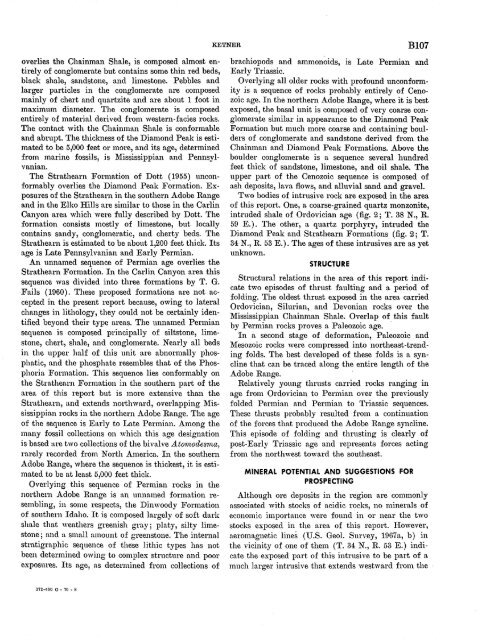RESEARCH· ·1970·
RESEARCH· ·1970·
RESEARCH· ·1970·
Create successful ePaper yourself
Turn your PDF publications into a flip-book with our unique Google optimized e-Paper software.
over lies the Chainman Shale, is com posed almost entirely<br />
of conglomerate but contains some thin red beds,<br />
black shale, sandstone, and lin1estone. Pebbles and<br />
larger particles in the conglomerate are con1posed<br />
1nainly of chert and quartzite and are about 1 foot in<br />
maximum diameter. The conglomerate is composed<br />
entirely of tnaterial derived frmn western-facies rocks.<br />
The contact with the Chainman Shale is conformable<br />
and abrupt. The thickness of the Diamond Peak is estimated<br />
to be 5,000 feet or 1nore, and its age, determined<br />
frmn marine fossils, is ~1ississippian and Pennsylvanian.<br />
The Strathearn Formation of Dott ( 1955) unconformably<br />
overlies the Diamond Peak Formation. Exposures<br />
of the Strathearn in the southern Adobe Range<br />
and in the Elko llills are similar to those in the Carlin<br />
Canyon area which were fully described by Dott. The<br />
formation consists mostly of limestone, but locally<br />
contains sandy, conglomeratic, and cherty beds. The<br />
Strathearn is estimated to be about 1,200 feet thick. Its<br />
age .is Late Pennsylvanian and Early Permian.<br />
An unnamed sequence of Permian age overlies the<br />
Strathearn Formation. In the Carlin Canyon area this<br />
sequence was divided into three formations by T. G.<br />
Fails ( 1960). These proposed formations are not accepted<br />
in the present report because·, owing to lateral<br />
changes in lithology, they could not be certainly identified<br />
beyond their type areas. The unnan1ed Pennian<br />
sequence is composed principally of siltstone, limestone,<br />
chert, shale, and conglomerate. Nearly all beds<br />
in the upper half of this unit are abnormally phosphatic,<br />
and the phosphate rese1nbles that of the Phosphoria<br />
Formation. This sequence lies confonnably on<br />
the Strathearn Formation in the southern part of the<br />
area of this report but is 1nore extensive than the<br />
Strathearn, and extends northward, overlapping ~1ississippian<br />
rocks in the northern Adobe Range. The age<br />
of the sequence is Early to Late Permian. An1ong the<br />
many fossil collections on which this age designation<br />
is based are two collections of the bivalve A.t01nodesn1a,<br />
rarely recorded from North America. In the southern<br />
Adobe Hauge, where the sequence is thickest, it is estimated<br />
to be at least 5,000 feet thick.<br />
Overlying this sequence of Permian rocks in the<br />
northern Adobe Hange is nn unnamed fonnation resembling,<br />
in some respects, the Dinwoody Fonnation<br />
of southern Idaho. It is composed largely of soft dark<br />
shale that weathers greenish gray; platy, silty liinestone;<br />
and a. small amount of greenstone. The internal<br />
stratigraphic sequence of these lithic types has not<br />
been determined owing to complex structure and poor<br />
exposures. Its age, as determined frmn collections of<br />
KETNER<br />
B107<br />
brachiopods and ammonoids, 1s Late Permian and<br />
Early Triassic.<br />
Overlying all older rocks with profound unconformity<br />
is a sequence of -rocks probably entirely of Cenozoic<br />
age. In the northern Adobe Range, where it is best<br />
exposed, the basal unit is composed of very coarse conglomerate<br />
similar in appearance to the Diamond Peak<br />
Formation but n1uch more coarse and containing boulders<br />
of conglon1erate and sandstone derived from the<br />
Chaimnan and Diamond Peak Formations. Above the<br />
boulder conglmnerate is a sequence several hundred<br />
feet thick of sandstone, limestone, and oil shale. The<br />
upper part of the Cenozoic sequence is composed of<br />
ash deposits, lava flows, and alluvial sand and gravel.<br />
Two bodies of intrusive rock are exposed in the area<br />
of this report. One, a coarse-grained quartz monzonite,<br />
intruded shale of Ordovician age (fig. 2; T. 38 N., R.<br />
59 E.). The other, a quartz porphyry, intruded the<br />
Diamond Peak and Strathearn Formations (fig. 2; T.<br />
34· N., R. 53 E.). The ages of these intrusives are as yet<br />
unknown.<br />
STRUCTURE<br />
Structural relations in the area of this report indicate<br />
two episodes of thrust faulting and a period of<br />
folding. The oldest thrust exposed in the area carried<br />
Ordovician, Silurian, and Devonian rocks over the<br />
~1ississippian Chainman Shale. Overlap of this fault<br />
by Permian rocks proves a Paleozoic age. ·<br />
In a second stage of defonnation, Paleozoic and<br />
~1esozoic rocks were compressed into northeast-trending<br />
folds. The best developed of these folds is a syncline<br />
that can be traced along the entire length of the<br />
Adobe Range.<br />
Relatively young thrusts carried rocks ranging in<br />
age fron1 Ordovician to Permian over the previously<br />
folded Permian and Permian to Triassic sequences.<br />
These thrusts probably resulted frmn a continuation<br />
of the forces that produced the Adobe Range syncline.<br />
This episode of folding and thrusting is clearly of<br />
post-Early Triassic age and represents forces acting<br />
fron1 the northwest toward the southeast.<br />
MINERAL POTENTIAL AND SUGGESTIONS ·FOR<br />
PROSPECTING<br />
Although ore deposits in the region are comn1only<br />
associated with stocks of acidic rocks, no 1ninerals of<br />
economic importance were found in or near the two<br />
stocks exposed in the area of this report. However,<br />
aeromagnetic lines (U.S. Geol. Survey, 1967a, b) in<br />
the vicinity of one of thmn (T. 34 N., R. 53 E.) indicate<br />
the exposed part of this intrusive to be part of a<br />
nulCh larger intrusive that extends westward frmn the<br />
372-400 0 - 70 - 8
















